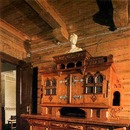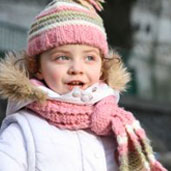Victor Vasnetsov's House Museum
11.09.2014 22:40 Просмотров: 270
 From 1986 the All-Union Association of the State Tretyakov Gallery (renamed the All-Russia Association in 1994) has encompassed the Vasnetsov House Museum on Vasnetsov Pereulok (formerly Trety Troitsky Pereulok) in it’s collection of buildings. It was opened in 1953. Today its collection comprises 25,000 exhibits which assist us in finding out more about the life and creative work of the famous artist.
From 1986 the All-Union Association of the State Tretyakov Gallery (renamed the All-Russia Association in 1994) has encompassed the Vasnetsov House Museum on Vasnetsov Pereulok (formerly Trety Troitsky Pereulok) in it’s collection of buildings. It was opened in 1953. Today its collection comprises 25,000 exhibits which assist us in finding out more about the life and creative work of the famous artist.
The house and studio where Victor Vasnetsov lived between 1894-1926 was built to his own architectural design from plans, which he himself drew between 1893 and1894. The design is a wonderful example of the Neo-Russian style. He combined his love for old Russian architecture with the influence of the then, developing Art Nouveau. The multi-dimensional architectural construction with its high roof, wooden wing, decorative window frames and spray glazed tiles, embrace the artist’s appeal for creating a pleasant and harmonious living space.
The interior décor is modelled on a National Romantic theme. The first floor suite of rooms connects the sitting and dining rooms with the living quarters where Vasnetsov’s wife and children lived. In the sitting and dining rooms the wooden furniture was made to a traditional Russian design at the Abramtsevo and Stroganov workshops, as well as in Vyatka, from drawings by V.Vasnetsov and his brother Arkady. The interior decor in the dining room is reminiscent of a peasant log cabin. Moscow intellectuals met in the sitting-room every Wednesday. Vasnetsov’s visitors included P.Tretyakov, I.Repin, V.Surikov, V.Polenov, F.Shalyapin, V.Serov and S.Mamontov…
The most important room in the house was the artist’s studio on the second floor. Many outstanding works were created here (including the famous Warrior Knights, 1881-1898). The paintings now on display in the studio were produced in the 1900s. Almost all of them were inspired by images taken from Russian folklore. .They include seven paintings which the artist called the "Poem of Seven Fairy Tales", They include The Sad Princess, The Frog Princess and The Flying Carpet, 1919-1926. Vasnetsov favourite epic "warrior" theme continued with "The Battle of Prince Ivan and the Three-Headed Serpent" and “The Battle of Dobrynya Nikitich and the Seven-Headed Firedrake” 1918.
Much of the artist’s creative work was focussed on monumental works, which include the mosaics in the Church of the Resurrection of Christ in St.Petersburg (1883-1901), and the frescoes in St Vladimir Cathedral in Kiev (1885-1896). Many of his sketches and studies are stored in the museum.Vasnetsov’s last work was the portrait of his friend M.V.Nesterov.The museum exhibition enables visitors to truly recognize the value and diversity of Victor Vasnetsov’s creative legacy. The artist attempted to create an integral style encompassing different kinds of art based on medieval Russian national and folklore traditions. The house itself became a spiritual retreat from the noise and bustle of the outside world where he found the spiritual peace and inspiration to create his works of art.
Phone: (+7) 495 681 13 29
Address: Vasnetsov per. 13
Open 10.00 - 17.00. Closed Mon,Tue, last Thu of the month.




See other:
 Museum of Optical illusions
On the 29th of July a new Museum of Optical illusions was opened not far from the main pedestrian Street of Moscow – Arbat.
Подробнее...
Museum of Optical illusions
On the 29th of July a new Museum of Optical illusions was opened not far from the main pedestrian Street of Moscow – Arbat.
Подробнее...  Multimedia Art Museum
The Multimedia Art Museum in Moscow is a Russian state museum dedicated to the presentation and development of actual art related to new multimedia technologies. The mu... Подробнее...
Multimedia Art Museum
The Multimedia Art Museum in Moscow is a Russian state museum dedicated to the presentation and development of actual art related to new multimedia technologies. The mu... Подробнее...  Garage Museum of Contemporary Art
Through an extensive program of exhibitions, events, education, research, and publishing, the institution reflects on current developments in Russian and international ... Подробнее...
Garage Museum of Contemporary Art
Through an extensive program of exhibitions, events, education, research, and publishing, the institution reflects on current developments in Russian and international ... Подробнее...  Electro Museum
The Electro Museum opened in 2014 immediately aroused great interest among the citizens and guests of the city because of its unusual exposition devoted to the actual e... Подробнее...
Electro Museum
The Electro Museum opened in 2014 immediately aroused great interest among the citizens and guests of the city because of its unusual exposition devoted to the actual e... Подробнее...  Coca-Cola Museum
Coca-Cola World museum has been reopened after reconstruction at the Coca-Cola Hellenic plant in Moscow.
Подробнее...
Coca-Cola Museum
Coca-Cola World museum has been reopened after reconstruction at the Coca-Cola Hellenic plant in Moscow.
Подробнее... Our Friends
Contact us
E-mail: admin@anothercity.ru








